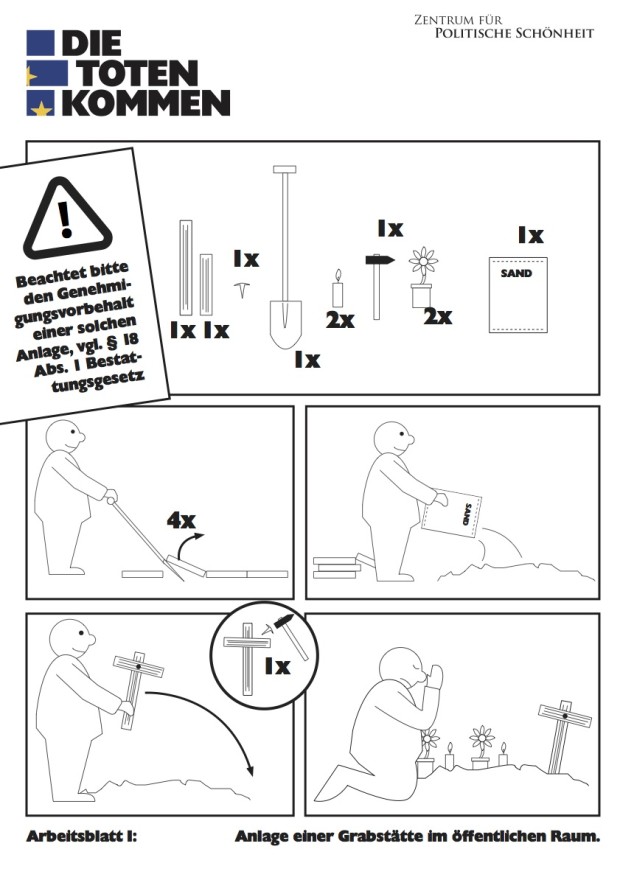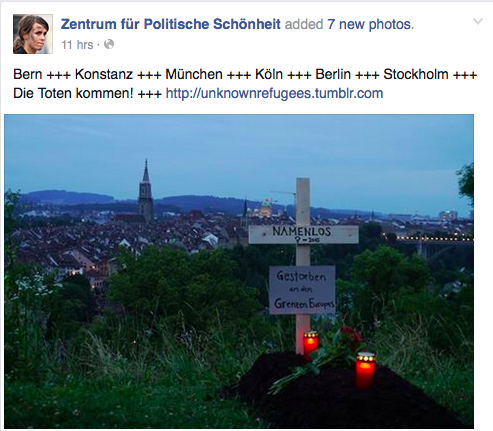This evening I met up with an old friend in Kreuzberg and we decided to walk up to Schinkel’s Prussian National Monument for the Liberation Wars in Viktoriapark. From the top we discussed how the view might have looked at the time of the monument’s inauguration in 1821 and I told my friend about Neil MacGregor’s recent radio series, Germany: Memories of a Nation, and in particular the one episode (Iron Nation) in which the monument briefly features. As the sun set we descended, tracing the edges of the Kreuzberg waterfall. It was then that we noticed, on a small island of one of the waterfall’s pools, a crudely made wooden cross marking a mound of earth, a grave, and inscribed simply with the word ‘solidarity’.
We both recognised the grave as part of a critical art campaign led by the Centre of Political Beauty (Zentrum für Politische Schönheit) entitled The Dead Come (Die Toten Kommen), which I have followed in recent days through the campaign’s Facebook feed and Twitter account. As explained in more detail on the Centre’s permanent and campaign website, its researchers have identified the resting places of the thousands of individuals who, in recent years, died trying to get into Festung Europe – Fortress Europe. Locating the victims in inhumane, forgotten and mass graves in the peripheries of Southern European states the campaign vowed to exhume some of their bodies in co-operation with victim’s relatives, imams, priests and proffesional undertakers, and in their words, ‘take the problem to Germany‘. The campaign has so far raised over €50,000 through crowd-sourcing in order to present some of the victims’ bodies to their ‘bureaucratic murders’ in the heart of Berlin. This intention reached a crescendo this afternoon when thousands of protestors converged on the centre of Berlin’s governmental quarter to dig hundreds of symbolic graves, like the one in Viktoriapark, to ‘unknown refugees’ on the Reichstag lawn.Their actions did not go unnoticed – partly because a few days earlier the Centre’s activists had erected a building plan development placard in front of the German Chancellery declaring that the European Union was building a cemetery to the dead refugees on the site. When they returned in greater numbers to dig the planned graves they faced Berlin’s riot police and metal fences and subsequently fifty campaigners were arrested.
The Centre’s efforts to draw attention to the mnemonic non-representation of the victims of Europe’s stringent border controls, as a mean to critically reflect on and protest the supposed legitimacy of those controls, began last November, around the 25th Anniversary of the fall of the Berlin Wall. It was then that in a controversial and highly publicised action the Centre’s activists stole a number of memorial crosses dedicated to victims of the Berlin Wall and re-erected them at the European Union’s fortified border in Northern Africa in order to signify the region’s ‘new walls’. Their efforts mark an arguably more confrontational form of Germany’s model of ‘active remembrance’ (aktives gedenken) – a continuous effort to maintain public remembrances and awareness of the country’s difficult twentieth century past, often through performative art practices, that has its roots in the widespread social, political and cultural changes associated with the so-called ’68 generation and as, at least partly, founded upon Theodor Adorno’s writings on the necessarily never-ending nature of working through the past. In fact, the actions of those who dug hundreds of symbolic graves in front of the Reichstag yesterday echo those of an earlier group of memory activists involved in a similar action discussed by Karen Till called ‘let’s dig’, which took place in 1985 on the grounds of the former Gestapo and SS headquarters (what is now the Topography of Terror). A key difference between these similar action, however, relates to the transcultural, and indeed transnational, frames of the Centre’s more recent activ(ist) forms of remembrance. While those digging in 1985 did so under the motto ‘we stand upon graves’ those digging just a couple of kilometers to the north but thirty years later brought the graves from the periphery of Europe to its centre. In this way, the Centre’s activists not only further legitimise claims for the paradigmatic shift in the study of social memory towards a third phase of research that emphasises memory’s multidirectional (Rothberg 2009), transcultural and traveling nature (Erll 2011). They also problematized, once again, the revival of Germany’s dominant role in Europe (and its seeming unease with such responsibility).
It was hard for my friend and I to miss the poignancy of stumbling across an unknown refugee’s grave surrounded by the waters that flowed down from a monument dedicated to the war that marked modern Germany’s foundation. The resonance of later re-listening to a couple of Neil MacGregor’s episodes was also striking. MacGregor commends the daily activity around the monument today, just as I and my friend experienced it, as a positive reflection of Berlin’s multi-cultural and multi-ethnic diversity, while noting in a separate episode how Germany is a ‘land of floating frontiers and shifting configurations’ in which an ‘uncertainty about ‘where your state begins and ends… has been a central reality of German life for a thousand years‘. The Centre of Political Beauty activities are symptomatic of this but perhaps more importantly they remind us that we need to extend the multi-culturalty and multi-ethnicity that often characterise our local neighbourhoods to the greater regions of Europe and the World and that in Germany, as is arguably the case for any other country, it is no longer sufficient to address the memories of a nation. Instead we should turn our attention to transformational politics which might help stem the number of needless deaths by employing memory-tactics of a more transcultural nature. If you want to contribute to this project you might consider following the instructions below and digging a grave to an unknown refugee in your own country and city and thus, like those who recently extended the project beyond Germany to Switzerland and Sweden, help the Centre’s campaign overcome even more borders. More photographs can be found here. 





